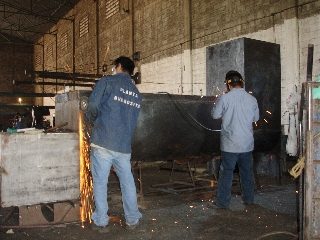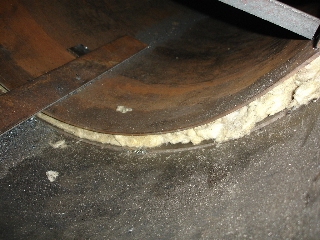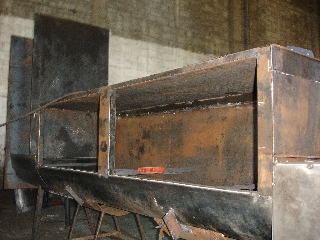HOME
Portable BBQ Smokers
Portable BBQ Smokers Insulated
Portable BBQ Grills
Portable Rotisseries
BBQ Grills
Backyard BBQ Pits
Outdoor fire pits
BBQ Smokers Photos
Delivery info.
About us
Comments
Contact us
|
INSULATED PORTABLE BBQ
SMOKERS
Even though traditional offset BBQ
smokers produce great BBQ and are practical to use, when it comes to heat
conservation they are not the most efficient ovens.
They lose heat through the smokestack, the lids and the walls of the BBQ
smoker itself.
When barbecuing we open, close and adjust the smokestacks and the lids
loosing heat while doing so. As a fabricator and designer there is not much
we can do about that but... the walls of the BBQ Smoker are another matter.
There are three things to consider when it comes to heat loss through the
smoker walls:
*The thickness of the wall,
*The difference in temperature between the inside and outside of the smoker,
*The material used in the wall of the smoker.
A thicker wall looses less heat than a thinner one. The larger the
difference in temperatures the more heat will be lost. The thermal
conductivity of the material used is the biggest factor regarding the heat
loss through the wall, the higher the conductivity the bigger the heat loss.
One way to measure thermal conductivity is BTU/h*ft*F. This basically
means BTUs per hour, in an area measured in feet and in Fahrenheit degrees.
AT 250 F, the thermal conductivity of steel is around 30 BTU/h*ft*F and for
mineral wool is 0.304 BTU/h*ft*F. It is easy to see that steel is one
hundred times a better heat conductor than insulation.
Below is a table that compares the rate of heat loss per hour through a 3/8"
thick steel wall vs. an insulated steel wall (both one foot square) at
different outside temperatures.
| |
|
HEAT LOSS |
HEAT LOSS |
| Outside |
Smoker |
3/8" thick |
Double wall |
| temperature |
temperature |
Single wall |
Insulated |
| |
|
smoker |
Smoker |
| 100 |
250 |
144,600 BTU |
545 BTU |
| 90 |
250 |
153,600 BTU |
581 BTU |
| 80 |
250 |
163,200 BTU |
618 BTU |
| 70 |
250 |
172,800 BTU |
654 BTU |
| 60 |
250 |
182,400 BTU |
690 BTU |
| 50 |
250 |
192,000 BTU |
727 BTU |
| 40 |
250 |
201,600 BTU |
763 BTU |
As you can see, the heat loss difference between an insulated
and non-insulated wall is about 264 times.
It is so vast that that the steel thickness is not really
relevant.
Some of the “on the field” benefits of an insulated BBQ
smoker are:
- More constant temperature inside the smoker
- The cooking temperature holds much better to changes in
weather
- Less air flow inside the smoker
- Less tending to the fire required
- Tremendous savings in wood
- Friendlier to be around (The outside of the smoker
is not as hot as regular smokers. This is particularly
important if there are kids)
- Protects the paint
- Protects from rust
If you are including heat conservation in your set of
parameters or, if you want one of the best smokers available
today then the fully
insulated BBQ Smoker is your smoker.
  
Here is an insulated BBQ smoker in process. The center photo shows the insulation between the two steel walls.
We actually build a BBQ smoker inside another BBQ smoker... with mineral wool in between!
Any BBQ Smokers you like?contact us!
OLD COUNTRY BBQ PITS
6700 SANTA MARIA AVE. * LAREDO TEXAS, 78041
(210)
875-1808
E-Mail:
grills@oldcountrybbqpits.com

Home
Portable BBQ Smokers
Portable BBQ Grills
Backyard BBQ Pits
Outdoor fire pits
BBQ Smokers photos
Delivery info.
About us
Contact us
|






Why
are our BBQ Pits priced so low???